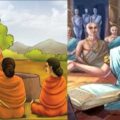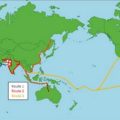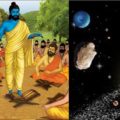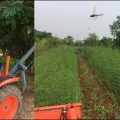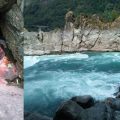Paraśurāma Flourished around 11177 BCE; Recovered Land from Sea
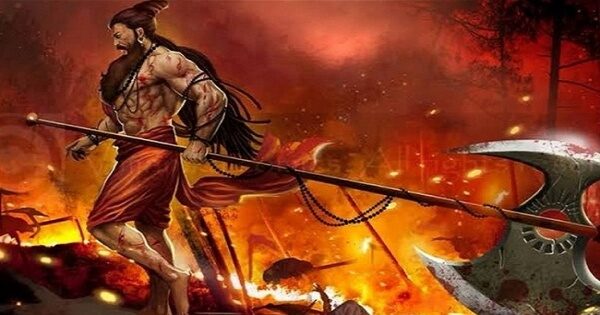
Paraśurāma, son of Jamadagni, flourished around 11177 BCE in the Rigvedic era and was born on Vaishakha Shukla Tritiya (Akshaya Tritiya). He was a junior contemporary of Kārtaviryārjuna of Māhiṣmatī. Arjuna Kārtavīrya defeated Karkoṭa Nāga and occupied the city of Māhiṣmatī. Arjuna Kārtavīrya had many sons. Once Kārtavīrya and his sons visited the hermitage of Jamadagni (a descendant of Jamadagni I) and killed Jamadagni in a conflict over Kāmadhenu. Paraśurāma, son of Jamadagni, came to know about the incident from his mother. He killed all the sons of Kārtavīrya except five – namely Jayadhvaja, Śūrasena, Vriṣabha, Madhu and Urjita (तस्य पुत्रसहस्रेषु पञ्चैवोर्वरिता मृधे । जयध्वजः शूरशेनो वॄषभो मधुरूर्जितः ॥). Later, Paraśurāma went to South India and settled at Paraśurāma-Kśetra (Konkan and Malabar Coast).
Paraśurāma founded 64 villages in Parashurama-kshetra which were reorganized into four groups namely, Tulu, Kupa, Kerala and Mūṣika. Out of 64 villages, 32 villages have been established in the Tulu region. Many families of Brahmanas had migrated from the banks of Vedic Sarasvati River to Paraśurāma Kśetram during the Rigvedic era. Paraśurāma brought a poor Brahmana and his family from the banks of Krishna River who became the preceptor (Yogatripad Yogiar) of all Namboodiri Brahmanas of Kerala. Paraśurāma also brought the Brahmanas of Bhāradwāja and Kaśyapa gotras from the Chola kingdom.
According to the legend of Parashurama Kshetra found in Ramayana, Mahabharata and Brahmanda Purana, Paraśurāma recovered the land from the Sea. Scientific studies reveal that some parts of present-day Goa appear to have been uplifted from the sea due to geological tectonic plate movement. There is evidence to support this theory as indicated by the presence of marine fossils, buried seashells and other features of reclaimed topography in the coastal belt. The evidence provided by the conch shells at Surla village, fossilized marine conch shells discovered in 1863, petrified roots, fossilized branches have been found later in many villages on the foothills of the Sahyadri dating back more than 10,000 BC. Thus the geologists concluded that Goa has risen up from the seabed as a result of violent tectonic movements. At the decline of the intensity of pluviation in the last Pleistocenic age around 10.000 BC, the bottom of Deccan plateau was lifted up and out of sea-waters by the tectonic movements, forming the West-coast of India, Goa being a part thereof.
Paraśurāma Era
James Princep mentions that Kerala regions followed an epoch of 1176 BCE, which derives its name from a prince, who is supposed to have reigned 1176 years before Christ. This era is reckoned in cycles of 1000 years. The year itself is solar, or rather sidereal, and commences when the Sun enters the sign Virgo (Kanyā Rāśi). The commencement of the 977th year of the 3rd cycle concurs with the 1st Āśvina of 1723 Śaka, i.e., 14 September 1800 CE.
Kerala traditionally followed the epoch of Paraśurāma since Rigvedic era. The vernal equinox occurred around 11177 BCE when Sun entered the sign Virgo, i.e., Kanyā Saṅkrānti. This epoch was reckoned in cycles of 1000 solar years. Seemingly, a prince of the Chera dynasty of the Sangam era had revived this epoch in 1176 BCE. Thus, the third cycle of 1000 years ended in 1823 CE. North Kerala’s Malayalam solar calendar follows the epoch of Kanyā Saṅkrānti. Interestingly, the epoch of the Paraśurāma era is identical to the epochal year of the centennium of the Saptarṣi era. In fact, the epoch of the later Kollam era (824 CE) was the commencement of the third cycle of 1000 years.
Image source: Jagran English.
Facebook Comments Box
The following two tabs change content below.
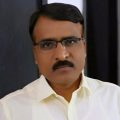
Vedveer Arya
Vedveer Arya is a civil servant and an officer of 1997 batch of Indian Defence Accounts Service (IDAS). A postgraduate in Sanskrit from University of Delhi, he is author of 'The Chronology of India'.

